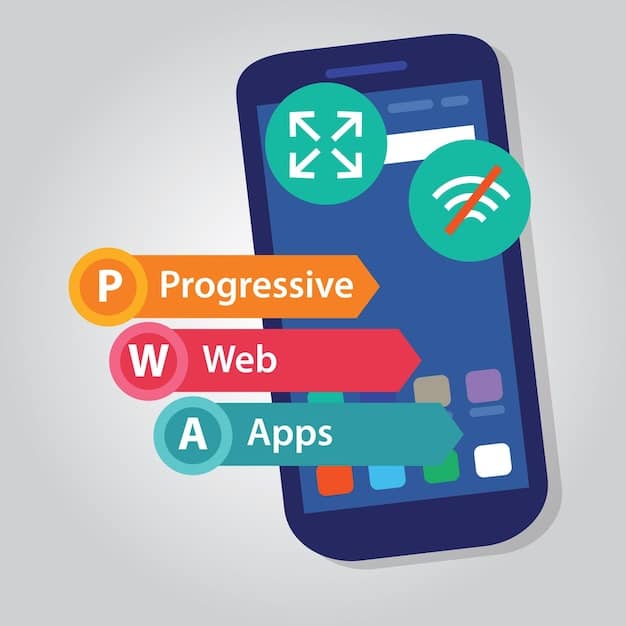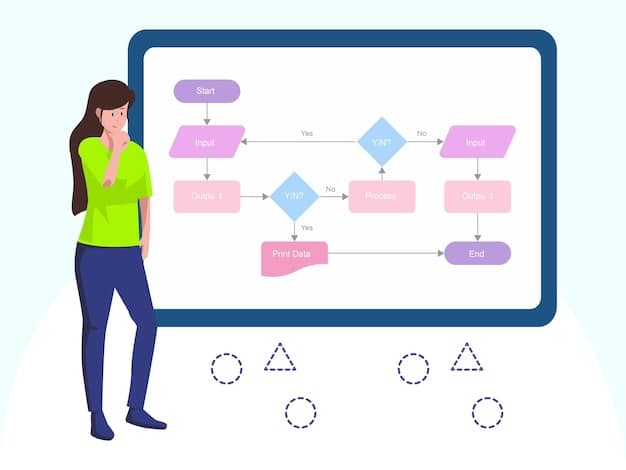Building PWAs with Service Workers: US Dev Guide (2025)

Building a Progressive Web App (PWA) with Service Workers empowers US developers in 2025 to create engaging, reliable, and fast web experiences by leveraging advanced caching strategies, push notifications, and offline capabilities for enhanced user engagement and performance.
Ready to elevate your web development skills? This comprehensive guide illuminates the path for US developers looking to master building a Progressive Web App (PWA) with Service Workers in 2025.
What are Progressive Web Apps (PWAs)?
Progressive Web Apps (PWAs) represent the evolution of web applications, designed to offer a native app-like experience directly within a web browser. They bridge the gap between traditional websites and mobile apps, delivering enhanced performance and usability.
Key Characteristics of PWAs
PWAs are defined by a set of core features that contribute to their app-like feel. These characteristics are crucial for delivering a superior user experience.
- Reliable: PWAs load instantly and function reliably, even in uncertain network conditions. Service Workers enable this by caching essential resources.
- Fast: PWAs offer a smooth, responsive user interface with fluid animations and quick load times. Performance optimization is key.
- Engaging: PWAs offer an immersive user experience with features like push notifications and the ability to be added to the home screen.
Benefits of PWAs for US Developers in 2025
For US developers in 2025, PWAs present several compelling advantages. They offer a cost-effective way to reach a wide audience without the complexities of native app development.
- Lower Development Costs: PWAs require a single codebase for both web and mobile, reducing development and maintenance expenses.
- Wider Reach: PWAs are accessible across all devices through a web browser, eliminating the need for app store downloads.
- Improved SEO: PWAs are easily discoverable by search engines, leading to increased organic traffic.

PWAs offer a compelling approach to web development, delivering the best of both web and native app worlds. By understanding their core characteristics and benefits, US developers can leverage PWAs to create engaging and high-performance web experiences.
Understanding Service Workers
Service Workers are the backbone of PWAs, acting as a programmable network proxy that sits between the web application and the network. They control network requests, cache resources, and enable offline functionality.
How Service Workers Work
Service Workers are event-driven scripts that run in the background, separate from the main browser thread. This allows them to perform tasks without blocking the user interface.
- Interception: Service Workers intercept network requests made by the web application.
- Caching: They can cache responses to serve them later, even when the user is offline.
- Push Notifications: Service Workers enable push notifications, allowing you to re-engage users with timely updates.
Service Workers have a defined lifecycle that includes registration, installation, and activation. Understanding this lifecycle is crucial for effectively managing Service Workers in your PWA.
Service Worker Lifecycle
- Registration: The browser registers the Service Worker script.
- Installation: The Service Worker is installed and can cache static assets.
- Activation: The old Service Worker is replaced with the new one, and it starts controlling network requests.
Properly managing the Service Worker lifecycle is essential for ensuring smooth updates and avoiding conflicts.

Service Workers are a powerful tool for enhancing the capabilities of web applications. By understanding their functionality, lifecycle, and best practices, US developers can create PWAs that deliver exceptional user experiences, even in challenging network conditions.
Setting up Your Development Environment
Before you begin building a Progressive Web App (PWA) with Service Workers, it’s important to configure your development environment correctly. This ensures a smooth and efficient development process.
Required Tools and Software
You will need the following tools and software to develop PWAs effectively:
- Text Editor: Choose a code editor like VS Code, Sublime Text, or Atom.
- Web Server: A local web server like Node.js’s http-server or Python’s SimpleHTTPServer.
- Browser: A modern browser like Chrome or Firefox with developer tools.
Creating a Basic Web App Structure
Start by creating a basic web app structure with the following files:
- index.html: The main HTML file.
- style.css: The CSS file for styling.
- app.js: The JavaScript file for app logic.
- manifest.json: The manifest file for PWA metadata.
- sw.js: The Service Worker file.
Organizing your files correctly will make your PWA more maintainable and easier to develop.
Setting up a well-organized development environment is crucial for efficient PWA development. With the right tools and a clear structure, you’ll be well-equipped to create a robust and engaging PWA.
Implementing Service Workers in Your PWA
Implementing Service Workers involves several key steps, including registering the Service Worker, caching assets, and handling network requests. Each step is crucial for ensuring your PWA functions correctly.
Registering the Service Worker
Registering the Service Worker is the first step in enabling its functionality. This is done in your main JavaScript file (e.g., app.js).
if ('serviceWorker' in navigator) {
navigator.serviceWorker.register('/sw.js')
.then(registration => {
console.log('Service Worker registered with scope:', registration.scope);
})
.catch(error => {
console.error('Service Worker registration failed:', error);
});
}
This code checks if the browser supports Service Workers and registers the sw.js file.
Caching Assets
Caching assets is essential for providing offline functionality. You can cache static assets like HTML, CSS, JavaScript, and images in the Service Worker’s install event.
const cacheName = 'my-pwa-cache-v1';
const assetsToCache = [
'/',
'/index.html',
'/style.css',
'/app.js',
'/images/logo.png'
];
self.addEventListener('install', event => {
event.waitUntil(
caches.open(cacheName)
.then(cache => {
console.log('Caching assets');
return cache.addAll(assetsToCache);
})
);
});
This code opens a cache and adds the specified assets to it during the installation phase.
Handling Network Requests
To handle network requests, you need to listen for the fetch event in your Service Worker.
self.addEventListener('fetch', event => {
event.respondWith(
caches.match(event.request)
.then(response => {
return response || fetch(event.request);
})
);
});
This code checks if the requested resource is in the cache. If it is, it returns the cached version. Otherwise, it fetches the resource from the network.
Implementing Service Workers correctly is crucial for leveraging the full potential of PWAs. By following these steps, you can create a PWA that offers a reliable and engaging user experience.
Advanced Service Worker Techniques
Once you have a basic Service Worker implementation, you can explore advanced techniques to further enhance your PWA’s capabilities. These include cache strategies and background synchronization.
Cache Strategies
Choosing the right cache strategy is crucial for optimizing performance and ensuring your PWA functions correctly in different network conditions.
- Cache First: Serve assets from the cache if available, and fall back to the network if not.
- Network First: Try to fetch assets from the network first, and fall back to the cache if the network is unavailable.
- Cache Only: Always serve assets from the cache.
- Network Only: Always fetch assets from the network.
- Stale-While-Revalidate: Serve assets from the cache immediately, and update the cache in the background.
Each strategy has its trade-offs, so choose the one that best suits your application’s needs.
Background Synchronization
Background synchronization allows you to defer tasks until the user has a stable network connection. This is useful for sending data to the server or updating the cache.
self.addEventListener('sync', event => {
if (event.tag === 'my-background-sync') {
event.waitUntil(doSomething());
}
});
This code listens for the sync event and executes the doSomething function when the background sync is triggered.
Mastering these advanced techniques can significantly improve the performance and functionality of your PWA. By carefully choosing your cache strategies and leveraging background synchronization, you can create a PWA that delivers an exceptional user experience.
Testing and Debugging Your PWA
Testing and debugging are essential parts of the PWA development process. Thorough testing ensures your PWA functions correctly across different devices and network conditions.
Using Browser Developer Tools
Browser developer tools provide powerful features for testing and debugging PWAs. In Chrome, you can use the Application tab to inspect Service Workers, caches, and manifest files.
- Service Workers: View the status of your Service Worker, unregister it, or force an update.
- Cache Storage: Inspect the contents of your cache and delete individual items.
- Manifest: Verify that your manifest file is correctly configured.
These tools make it easy to identify and fix issues in your PWA.
Common PWA Issues and Solutions
Here are some common PWA issues and their solutions:
- Service Worker Not Registering: Check for errors in your Service Worker registration code and ensure the Service Worker file is served with the correct MIME type.
- Cache Not Updating: Verify that your cache version is updated and that you are clearing the old cache.
- Offline Functionality Not Working: Ensure that you are correctly handling network requests in your Service Worker and that all necessary assets are cached.
Thorough testing and debugging are crucial for ensuring the success of your PWA. By utilizing browser developer tools and addressing common issues, you can create a PWA that delivers a reliable and engaging user experience.
| Key Point | Brief Description |
|---|---|
| 🚀 Service Workers | Enable offline access and enhance PWA performance. |
| 💾 Caching Strategies | Optimize asset delivery based on network conditions. |
| ⚙️ Background Sync | Defer tasks until a stable network connection is available. |
| 🛠️ Development Tools | Use browser tools to test and debug PWAs effectively. |
Frequently Asked Questions
▼
Service Workers enable offline functionality and significantly improve the performance of PWAs by caching assets and handling network requests efficiently, leading to a better user experience.
▼
You can register a Service Worker by adding a script to your main JavaScript file that checks for Service Worker support and then registers the Service Worker file (e.g., sw.js).
▼
Common cache strategies include Cache First, Network First, Cache Only, Network Only, and Stale-While-Revalidate, each offering different approaches to asset delivery based on network conditions.
▼
Browser developer tools provide essential features for testing and debugging PWAs, allowing you to inspect Service Workers, caches, and manifest files to identify and resolve issues.
▼
The manifest.json file provides metadata about your PWA, such as its name, icon, and display mode, enabling users to install the PWA on their home screen for an app-like experience.
Conclusion
Building a Progressive Web App (PWA) with Service Workers offers a powerful way for US developers in 2025 to create engaging, reliable, and high-performance web experiences. By understanding the fundamentals of PWAs, Service Workers, and advanced techniques, you can leverage their full potential to deliver exceptional user experiences.





